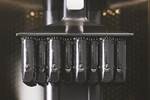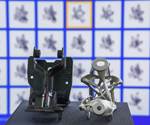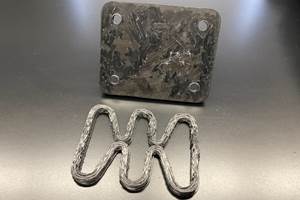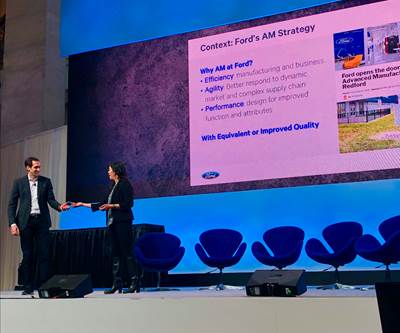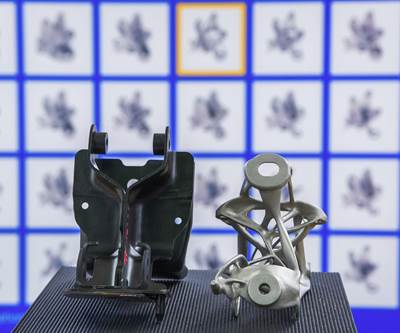3D Printing for Production at Ford: The Cool Parts Show #7
The parking brake bracket on the Mustang Shelby GT500 is now 3D printed instead of stamped. Learn how Ford is thinking about additive manufacturing in this episode of The Cool Parts Show.
Ford Motor Company is getting ready for the advance of additive manufacturing into full-scale production. A production part for a lower-quantity vehicle — a bracket for the parking brake system of the Ford Mustang Shelby GT500 — is now mass-produced through 3D printing.
In the past, comparable brackets were stamped instead, and they were made of metal where the printed parts are now polymer. The advantages of the new part are several: it is lighter-weight; additive manufacturing allowed a design that replaces separate right- and left-hand versions with a single part; and the freedom to produce without a stamping die or hard tooling of any kind allowed for easy modification and rapid iteration of the design. In this episode of The Cool Parts Show, 3D printing leaders at Ford describe how the impact will be bigger than the bracket, because with this part and others, the automaker is learning lessons and developing practices that will be increasingly valuable as additive takes on a bigger production role. | Season 2 of The Cool Parts Show brought to you by Carpenter Additive.
The Cool Parts Show is a video series from Additive Manufacturing Media that explores the what, how and why of unusual 3D printed parts. Watch more here.
Have a cool part to share? Email us.
Transcript
Peter Zelinski, Additive Manufacturing
Does additive manufacturing have a role in automotive part production? We talk to one of the major automakers about that and we look at a production part that they’re making additively on this episode of The Cool Parts Show.
Stephanie Hendrixson, Additive Manufacturing
Special thanks to Carpenter Additive, the season 2 sponsor of The Cool Parts Show. Stick around to the end of each episode as we tour their Emerging Technology Center here in Athens, Alabama. Now back to the show.
Peter Zelinski
I’m Peter Zelinski.
Stephanie Hendrixson
I’m Stephanie Hendrixson.
Peter Zelinski
We’re with AdditiveManufacturing.Media.
Stephanie Hendrixson
And this is The Cool Parts Show, our video series about cool 3D printed parts made by viewers like you.
Peter Zelinski
This is, in fact, season 2 of the Cool Parts Show. This is our first episode of season 2. We’re going to talk about scale production additive manufacturing. On AdditiveManufacturing.Media we’ve been writing about this a lot. We’ve been watching the advance of additive technology as a solution for quantity production parts. So I have an automotive production part made additively, made through 3D printing. This is a bracket that’s part of the parking brake system on a Ford Mustang.
Stephanie Hendrixson
OK. So just to be clear, this is not a prototype part for a test vehicle. It’s not a legacy spare part kind of thing. It’s a real part going onto new cars.
Peter Zelinski
Yeah. It’s none of those things. This is original equipment, a mass produced part put on the vehicle when it’s being made new. But let me quickly say, this is for a special vehicle. The car in question is part of Ford’s Performance line, formerly called Ford Racing. This part is for a Ford Mustang, Shelby GT 500, which retails for about seventy three thousand dollars. So this part is not made in the hundreds of thousands, but it is made by the thousands.
Stephanie Hendrixson
And so this was 3D printed. I’ve got to guess about how they made this. But what was the process used?
Peter Zelinski
Well, what’s your guess?
Stephanie Hendrixson
It looks to me like a Carbon CLIP part.
Peter Zelinski
You’re right. This was made using Carbon’s CLIP process. You’ve written about production applications of that process. Maybe you can describe for us what’s CLIP.
Stephanie Hendrixson
CLIP stands for Continuous Light Interface Production. It’s digital light synthesis, DLS. And so basically you’ve got this build platform that’s hanging over a vat of resin. The machine is using light and oxygen to selectively cure that resin as the build plate rises. And so you end up with these parts that are hanging upside down. You’ve got to clean off the excess resin. And then most of the materials that Carbon has, I believe also need a second cure in an oven to fully set. But the key to this whole process is that it’s continuous. Right? So the build platform is not pausing after each layer. It just keeps rising very, very slowly. And so you end up with these parts that are supposed to be isotropic, the same strength in all different directions. And they don’t have the same kind of layer lines that you would see on like an FDM part. And that’s kind of what tipped me off. You don’t see really clear layer lines in this part.
Peter Zelinski
Yeah, that’s right.
Stephanie Hendrixson
I’m with you on the process. But why is Ford using CLIP to make this bracket?
Peter Zelinski
There are a few advantages of making this part additively. In the past the comparable version of this part would have been made of metal and would have been stamped. And to do stamping you need a tool. Additive manufacturing is a way to eliminate that tooling investment. Just start making parts without any tooling. Additive also let them use plastic for this part. It created a practical way to use plastic and that has resulted in a lighter part. This is about 40 percent lighter than the comparable part on another car. And that comparable part on other cars comes in a left- and right-hand version. But complexity is much easier to do in additive and what it let Ford do in the case of this part is make an ambidextrous version of the part. So there’s no left and right hand anymore; the same part could go in either orientation and work either way.
Stephanie Hendrixson
Those are a lot of really good reasons to use CLIP. But I guess what I’m kind of asking is: Ford knows how to make this part with metal stamping, so why would they go to 3D printing? Why a totally different manufacturing process?
Peter Zelinski
Ford wants to start learning lessons about additive that it can apply as it does more and more parts additively. It wants to get ready for the arrival of this technology. Ford wants to kind of push some parts into being produced additively so it can start to do that learning, start to rise up that learning curve. Ellen Lee is one of the leaders at Ford in thinking about how the company can use additive. She talks about the design freedom that was used to create this part and kind of the development process that went into this.
Ellen Lee, Ford Motor Company
The biggest advantage to using additive manufacturing was that we are were to address a relatively low volume production part with a cost avoidance that came from tooling. So we’re able to have a very good value proposition while also learning how to designe for additive manufacturing. We fully embraced the ability to do these quick iterations during the design and validation steps. We had a total of 19 different design iterations going from the handed part to the ambidextrous part and then addressing all of the different failures that we encountered along the validation process. So interestingly, during the validation process of this, we had it on a test car on the track. It actually cracked. We were able to remove the part, understand what the failure mode was, and then redesign the part and have it back on the vehicle with the new design printed in the next day.
Peter Zelinski
So that’s a big change. The design process is fast. There’s no tooling. So changing some detail of the design doesn’t require any kind of hardware change. They just change the model and print a different version. They’ve got a new idea about how the shape of the part should be, even a subtle change, and they just keep iterating, iterating, iterating more and more and more new versions of this part until they get it exactly the way that they want. The design cycle moves that nimbly, that fast.
Stephanie Hendrixson
Ellen’s team has seen all of these benefits with 3D printing in the design process. But let’s get back to production, because the ultimate point is not just to design it better, design it faster, but to mass produce it with 3D printing. Right?
Peter Zelinski
That’s right. It’s a production part. It’s got to get into production. Harold Sears at Ford is part of the team that brought this part into production.
Harold Sears, Ford Motor Company
The team here does an awful lot of prototype work. So we support vehicle development, new engineering concepts by supplying them prototypes, and thousands a year. So when it came time to do this, because we’re really just developing the process, but we have to act like we’re in for high volume production. So many of our operators were a little bit shocked when they were suddenly handed a build schedule that said they needed to build X amount of parts over the next couple of days and this is how they were going to do it. It’s a new environment for everybody to start talking about how we do production with these types of systems. We take the questions from volume production. For example, a tool goes through a process of referred to as PPAP. PPAP is a process to prove a production tool is capable of consistently building the same part over and over. With these systems, because they’re not tools, it’s really a machine that’s building the parts. We still have to go through a PPAP-like process to understand, is it capable of building this part to tolerance time after time after time? So we learned things about machine to machine variation. We learned about placement within the build volume and that a part that’s built in the corner may not be quite the same as a part that’s built in the middle. And how do we compensate for that. And just the full process from the beginning, all the way to the end when the finished part is packed into a box and shipped to the plant.
Peter Zelinski
That’s what production is, right? It’s little things. It goes into production and the manufacturing engineers take over. And we respect manufacturing engineers, mad props to those people. But they think about little things, about getting the little things right. Detail after detail, process consistency in every little aspect of the process, getting all the details right and worked out. So that part after part after part after part comes out exactly the same way. That’s what production is.
Stephanie Hendrixson
And so this part is being produced right now just in limited quantities, thousands of parts. But I imagine the lessons they’re learning about design and manufacturing can be applied to lots of different parts going forward.
Peter Zelinski
Yeah. So right now, this is being made by the thousands for Ford’s Performance line. Additive technology advances. It makes its next advance soon and maybe it becomes a candidate for parts on luxury vehicles, you know, larger quantities still. And then from there, at some point in the future, I think not too many years in the future, the technology has advanced to the point in terms of the cost effectiveness, in terms of the production speed, that maybe it is a solution for some parts, certain parts that are on Ford’s most popular cars.
Stephanie Hendrixson
OK. So I think I got this. This is a 3D printed bracket made with the Carbon CLIP process. It is for the parking brake system of a Ford Mustang. And this is a plastic part replacing a sheet metal part that used to have to be made with a process that involved tooling. Switching to plastic allowed them to save 40 percent of the weight of this part and also implement some design changes so that instead of the right- and left-hand version, there’s just this one ambidextrous bracket that can go in either side of the car. So right now it’s being made in limited quantities, thousands of parts. But the lessons that Ford has been learning about design and production through 3D printing could be applied to greater quantities and broader product lines in the future.
Peter Zelinski
Well said, that’s a wrap. Thanks for watching The Cool Parts Show. Keep watching. We’ve got a lot more episodes for season two coming. If you want to tell us about your cool 3D printed part. Email us. CoolParts@AdditiveManufacturing.Media. Thanks for watching. Don’t forget to subscribe.
Sponsored content begins
Stephanie Hendrixson
We’re here at Carpenter Additive’s Emerging Technology Center in Athens, Alabama. You might know Carpenter as a supplier of metal powder for additive manufacturing, but this facility is actually set up for production. They have everything here to take something from powder all the way to a 3D printed part. That means that in addition to developing, atomizing, sieving and shipping powder, Carpenter is also 3D printing production parts using the powder bed fusion systems that you see behind me. But their materials expertise plays a role here too, because with additive, the better you understand the state of the powder going into the machine, the better you can control the output.
William Herbert, Carpenter Additive
PowderLife is an end-to-end process to monitor and manage the condition of your powder at every step. It takes the powder from the atomization all the way through into the additive manufacturing and through the recycling or the reuse process of that powder. What it does is it makes sure that we have statistical process controls at each point that are being logged digitally. And at the same time it gives us tools such as hoppers that allow us to keep our hands off and make it safe, economical and risk-free to use powder in additive.
Ben Ferrar, Carpenter Additive
The small Smart Hoppers work by a sensor inside them, which is monitoring the temperature, the humidity, the mass or the weight of powders in the hopper and also the oxygen content in the environment inside. Those properties in the environment can really affect how your material flows in an additive manufacturing machine, meaning that you can get powder characteristics which impact your final part properties.
Related Content
To Improve Performance of Compression Molded Composites, Add 3D Printed Preforms
9T Labs' Additive Fusion Technology enables the manufacture of composite structures with as much or as little reinforcement as is necessary, using 3D printed continuous fiber preforms to add strength just where needed.
Read More8 Social Media Posts About Additive Manufacturing: AM Radio #34
Cost savings, modifications, large-format AM and more. In this episode of AM Radio, we discuss what people are saying about additive manufacturing on social media.
Read MoreFaster Iteration, Flexible Production: How This Inflation System OEM Wins With 3D Printing
Haltec Corp., a manufacturer of tire valves and inflation systems, finds utility in 3D printing for rapid prototyping and production of components for its modular and customizable products.
Read MoreHow AM Enables Cobot Automation for Thyssenkrupp Bilstein (Includes Video)
The shock absorber maker has responded to its staffing shortages through extensive use of collaborative robots. In-house 3D printing makes this possible by providing the related hardware needed to complete the cobot-automated cells.
Read MoreRead Next
Ford in Production with On-Demand AM Polymer Parts
Ford and Carbon presented the first digitally manufactured polymer parts in production for the Ford Motor Company, created with Carbon’s digital light synthesis technology.
Read MoreAM 101: Digital Light Synthesis (DLS)
Digital Light Synthesis (DLS) is the name for Carbon's resin-based 3D printing process. How it works and how it differs from stereolithography.
Read More8 Times 3D Printing Built a Better Bracket
Brackets may not be the most exciting application for 3D printing, but they are one of the most important. Here are 8 instances where a 3D printed bracket offered advantages over a conventionally produced one.
Read More


